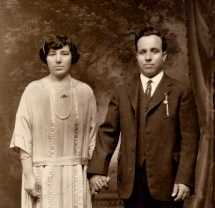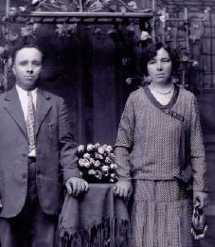Sign up for the Family Tree Newsletter Plus, you’ll receive our 10 Essential Genealogy Research Forms PDF as a special thank you!
Get Your Free Genealogy Forms
"*" indicates required fields
 |
 |
| Image A | Image B |
Linda Prybysz submitted two photographs of the same couple to find out more about them. I usually see photographs of couples taken several decades apart, but in this case both pictures date from the 1920s. Can you tell which photograph—Image A or B—was taken first? There are subtle differences in the pictures. Let’s see how many you can spot.
The 1920s brought radical change to women’s fashions. At the beginning of the decade, the 19th Amendment gave women the right to vote, and this new freedom translated itself into the clothing women wore. The boyish look was in and young women flocked to hair salons to have their hair cut short. Loose-fitting dresses with short skirts and dropped waists characterized the decade. Even undergarments changed from formfitting corsets to curve-flattening underwear. The popular press decided these fashion changes only encouraged young people to smoke, wear cosmetics, listen to jazz and relax their sexual mores. On the up side, shorter skirts and looser undergarments allowed women to more easily participate in sports and move freely while driving.
Men’s fashions during the 1920s did not change as dramatically. Men had a choice of either single or double-breasted suits, usually worn with a vest. Later in the decade, jackets had a more relaxed fit. There were several changes in pants, but they are not visible in these photographs. Until the mid-1920s, men’s shirts had detached collars. Shirts came in a variety of colors, but a majority of men wore white like the man in these images. By the late 1920s, ties became colorful and patterned.
Now that you have the background, let’s put the photographs in order. Image A was taken first. How can you tell? Take a close look at the couple’s accessories. She is wearing a long strand of beads and a bracelet on the upper part of her lower arm. In the 1920s, young women often wore bracelets on their upper arm and multiple strands of beads. In Image B, she is dressed simply with just a short strand of pearls. Likewise, in Image A, the gentleman is wearing a watch in his upper jacket pocket attached to his lapel with a small chain. Pocket watches were still the norm then. In Image B, he is not wearing any accessories.
The signs of aging in Image B are another clue. If you compare the woman’s face in each image, you can see subtle changes as she aged over the decade. The aging process is even more visible in the gentleman’s case because of his receding hairline and extra weight.
Their clothing also dates the images. In Image A, her dress is fairly typical for a young woman, while in Image B, her dress is conservative, suggesting she is older and possibly married. The man’s suit in Image A is a narrower cut than the one in Image B. In the first, his shirt has a detached collar while in the second, collar and shirt are one piece. His narrow dark tie in the earlier image is very different from the light colored patterned fabric in the later picture.
Now let’s look at their poses. In Image A, the man has closed the gap between them by grasping the woman’s hand. It appears he reached across the space between them at the last minute—the photographer didn’t have time to smooth out the wrinkles in his jacket sleeve. In Image B, the same space exists between the couple, except this time a table is placed between them. It is possible that the first picture was taken during their courtship and the second one a few years after their wedding. The flowers and arbor in the background of the later picture don’t seem to have significance other than being props.
There is one detail in the picture that has me puzzled. In the second picture the woman is holding a handkerchief in her left hand. Another researcher suggested that the handkerchief signified the loss of a child, but I couldn’t find a source for that symbolism. I’m curious to know if anyone has ever seen this before. Please send your suggestions to Maureen@familytreemail.com.
Find out how to submit your own picture for possible analysis by Maureen Taylor.
ADVERTISEMENT

